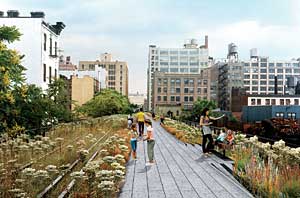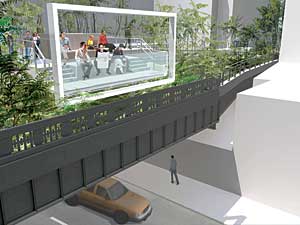Curating Wright
The Wright show disappoints in other ways, too. There’s no sense of a governing critical intelligence. The exhibition is simply a haphazard attic of Wrightiana, certainly fascinating for Wright buffs, but lacking a clear point of view. The title is the giveaway: Frank Lloyd Wright: From Within Outward. The idea is that Wright designed his buildings by first planning the interior spaces, and only then shaping the exterior appearance around them. Well, sure he did, but so what? This is a tired cliché, not a stirring theme for a new exhibition. It’s an idea for an old-fashioned show on a new-fashioned artist, because the truth is that Wright is as relevant today as ever. I’d rather have seen an exhibition on Frank Lloyd Wright: Environmentalist. Wright believed in building from local materials, not from costly stuff shipped halfway around the world. Often his buildings grow from the trees and rocks of the site they’re built on. And in a world that today is sinking into universal sameness, Wright was hypersensitive to the nature of place.


A friend recently came up with a definition of “place” I hadn’t heard before. “Place,” he said, “is space with meaning.” That’s a pretty good nutshell. The same week I visited the Guggenheim, I had another encounter with a “space with meaning,” when Ric Scofidio gave me a tour of the High Line, the transformation of an overhead New York City rail line into a linear park.
Part of the meaning of the High Line is its place in a larger narrative. The new park is a chapter in the story of the evolution of New York from an industrial seaport economy to a culture of leisure, culture, ideas, and tourism. The High Line becomes an emblem of that transformation. It’s a place in touch with both the past and the future.
It’s rich, too, in associations. It reminds you of the great Promenade Plantée in Paris, which helped inspire it. It recalls the great builder and destroyer Robert Moses, who constructed the High Line as part of the West Side Improvement project in the 1930s. It recalls, too, Jane Jacobs, who stopped Moses from building another overhead connector, the Lower Manhattan Expressway, and who would have loved to see his High Line transformed into a garden. One characteristic of good places is that they open a lode of connecting memories and associations. (MoMA gets another zero for this.)
This isn’t the place to review the High Line’s design, which isn’t yet finished (the first section, which runs from Gansevoort Street in the West Village to 20th Street in Chelsea, opened to the public on June 9). But as far as I could tell, the architects (it’s a collaboration between Diller Scofidio + Renfro and Field Operations) were getting everything right. Nothing has been sentimentalized; nothing looks “designed.” The planting is carefully contrived to look as if it just happened by chance, maybe when passing birds dropped the seeds. Nothing feels imposed. Your path is subtly directed, though, so that you’re intensely aware of the remains of the fading industrial world, where bold elements of concrete and steel still frame views of the city and the Hudson River. You’re equally aware of the essential three-dimensionality of urban space, too often ignored.
The seemingly accidental planting brings other associations to mind. One is with the similar rooftop gardens of Le Corbusier, like the one at his Carpenter Center at Harvard, where the original plan was to let the roof seed itself randomly over time. Another is a poem by William Carlos Williams, Spring and All, where the poet writes of weeds and grass in spring struggling for life on the road to a hospital:
Still, the profound change has come upon them: rooted, they grip down and begin to awaken.

Post a comment to this article
Report Abusive Comment